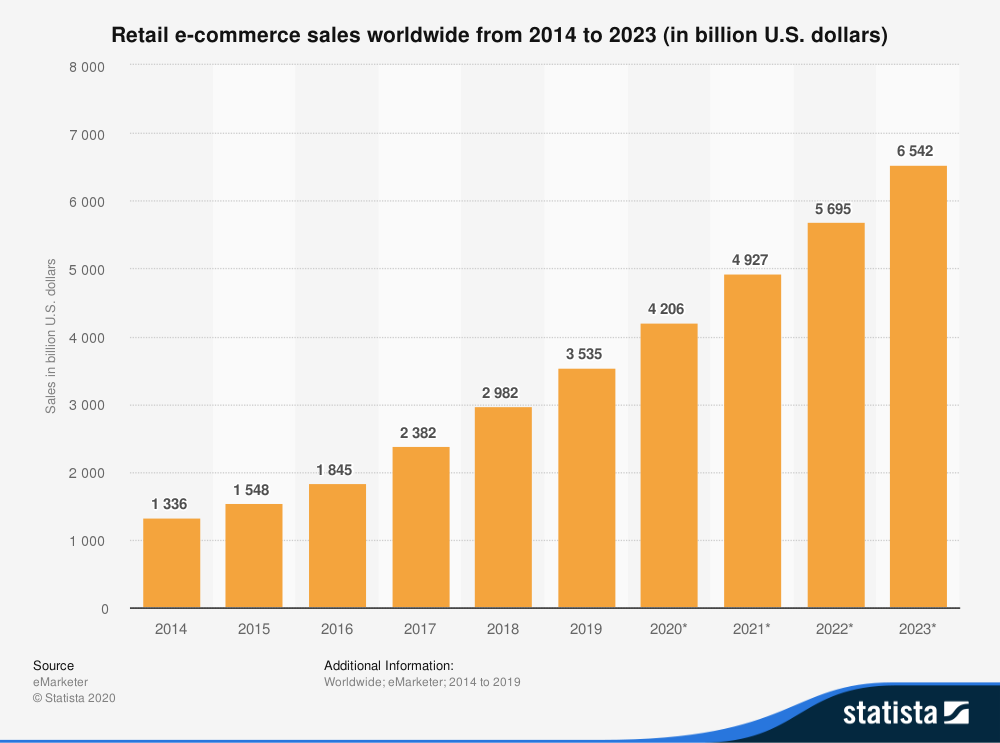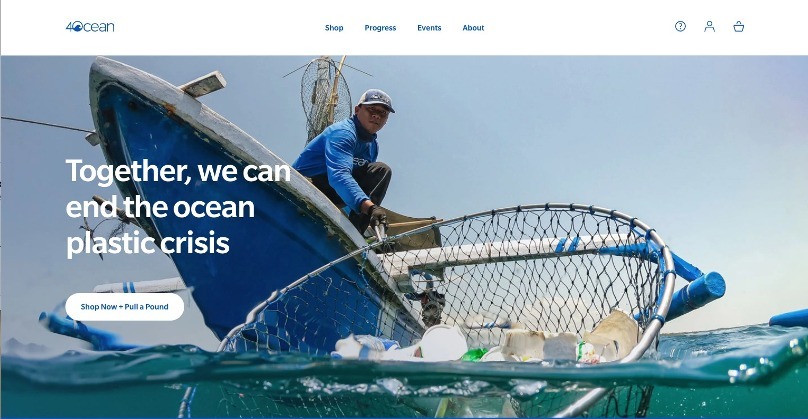Ecommerce is at the crossroads of business and technology—and it's constantly changing. The pandemic put online businesses at the forefront of the economy, and many of the online shopping habits customers adopted in 2020 are here to stay.
As more people turn to ecommerce for their needs and as technology continues to improve, ecommerce will only continue to grow.
Future of Ecommerce by the Numbers
Ecommerce retail purchases are expected to increase from 14% to 22% in 2023. And in 2020 alone, Digital Commerce 360 shared that ecommerce accelerated by two years to reach sales it would have otherwise reached in 2022.

According to data from eMarketer, household essentials were predicted to set the pace for ecommerce growth in 2020, with food and beverage sales poised for a 58.5% surge, while health, personal care, and beauty sales will jump 32.4%.
Clearly, 2020 changed ecommerce. But where does it go from here? Let's take a look at trends we're expecting to see in 2021.
7 Trends Shaping the Future of Ecommerce
There are several trends shaping how and where customers will be shopping. Depending on your industry, it's possible not all of these trends will make an appearance in your business. Let's jump in.
#1 Global Ecommerce Grows Outside of the U.S
Ecommerce is expected to grow around the world. Ecommerce retail is predicted to see revenue of $6.54 trillion in 2022, which is an increase from $3.53 trillion in 2019.

If you want your ecommerce business to get in on global growth, start by nailing down your target market. Who are your international customers? Learn about what they buy and how they shop.
Also, take a look at the payment methods offered on your ecommerce site. Customers outside of the U.S. may want to pay differently, and you'll need to accept those methods.
Consider how you'll enter this international market. This could be joining an existing online marketplace or updating your website to be global-friendly.
#2 Voice Recognition Will Be Prevalent
More consumers are utilizing voice assistants—Google's Assistant or Amazon Alexa, for example—and, as a result, voice commerce is on the rise.
According to Microsoft, 72% of people have performed a voice search using a digital assistant. This has encouraged large companies, such as Amazon and Starbucks, to make it easier for consumers to shop via voice commands. For example, Walmart partnered with Google to make sure a simple command, like "Hey Google, talk to Walmart", would allow customers to add items into an online Walmart cart.
But these franchises aren't the only ones turning to voice commerce. Making your ecommerce site more suitable for voice search can improve the way customers interact with your brand.
- Start by optimizing your site speed. Even if a customer isn't looking at your site, the site needs to load quickly.
- Next, revise your target keywords. People are going to search with different phrases when they're using a voice assistant. It's likely you'll use more long-tail keywords and phrases formatted in question-form.
- Then, make your site mobile responsive. You want to make sure all of the features are available and looking great on any mobile device.
#3 Customer Experience Marketing
Customer experience marketing is about how a brand engages its customers in various online portals across the web. As an ecommerce business, you want to provide an excellent shopping experience for the customer, no matter where they're at—social media, website, digital newsletter, etc.
Sometimes, improving customer experience means improving the employee experience. Some companies have boosted customer engagement by making the employee portal easier to navigate. Conduct an employee survey to see how you can better serve them, and as a result, better serve your customers.
You can also optimize the customer experience by implementing a loyalty program. As many as 70% of shoppers would like to participate in a loyalty program when spending money. About half of those customers admitted to spending more on purchases than they would have without the rewards program.
Moreover, do not forget that your customers expect to get their questions and requests addressed immediately. Especially when it comes to B2C ecommerce, time is really money. You simply cannot afford to hold your customers waiting, so make sure that you use technology, such as live chat, to your advantage. Study shows that 45% of site visitors prefer web chat to other contact channels. Its average response time comes down to 2 minutes 40 seconds, while other channels, for instance, social media or email, round up to respectively 10 and 12 hours.
Finally, you can also improve your customer experience by providing predictive selling from user data. Show the customer what they need based on their shopping habits with your company.
Video is in demand
According to Hubspot, 78% of Internet users watch online videos weekly, and 55% of them would take the time to watch videos every day.
Tools such as FlippingBook can complement written content with videos. This unique format can help keep your audience engaged. In addition to the authentic reading experience, you can embed videos across the pages of your flipbook, thus giving consumers more details about the items you sell online.
Interactive products
FlippingBook can also add interactivity into ecommerce. You can make your online catalog interactive: insert videos about each item, link back to item pages on your website for successful sales, turn each image into a pop-up so consumers could see everything in detail easily without having to zoom in.
Chatbots
Chatbots are AI-based instant messaging technology where site visitors or customers can chat with companies and get instant replies. Studies show that 69% of consumers prefer chatbots because they get quick responses to simple questions.
#4 Sustainable Ecommerce Blooms
Brands of all sizes are fulfilling customers' desire for eco-friendly and sustainable options.
If you want to make your business greener, start by updating your brand ethos. What part of your brand story benefits the environment? What is your view on sustainability? Your story should be reflected in all of your brandings, so customers have no mistake about who you are.

Source: Image adapted from The Open University
Another way to go green is to implement sustainable shipping options. Maybe it's using recyclable packaging or reducing the amount of packing you use. You might also consider outsourcing to eco-friendly fulfillment and 3PL companies that can help with sustainable options.
Depending on your industry, you might consider selling products that promote sustainability. These could help people live more eco-friendly and/or use sustainable products that replace something not eco-friendly.
You could also create an offset charge at checkout. This charge would help balance the amount of carbon dioxide by investing in reducing greenhouse gas emissions.
A great example of a company that is foundationally built on sustainability is 4Ocean. It’s an online store that sells bracelets and apparel, but is also dedicated to returning their profits to help clean up the Earth’s oceans of plastics. The store utilizes 100% recycled apparel mailers for their products.

Eco-friendly supply chain
You can take your eco-friendly efforts beyond shipping and products, all the way to the supply chain. Take a closer look at how your offices and warehouses are run.
The first step is to conduct an audit and see what's excessive. It's surprising how much energy you can reduce by turning off equipment when it's not needed. You can also invest in low energy lighting or reduce the temperature in the office.
Sustainable manufacturing
Depending on the products you're selling, there may be options for making the manufacturing more sustainable. Can you decrease the pollution your manufacturer is putting into the environment? You can also look into more efficient processes. Saving time producing the item means more time to power off equipment.
Zero-waste packaging
What you package and ship your products in can have a large impact on your sustainable efforts. Some small adjustments you can make include using boxes that properly fit your items, as large boxes waste space and use more packing material.
#5 Measurements across All Devices
Many consumers have and use different devices to access the Internet, including smartphones, tablets, and laptops. They also interact with brands from different access points, including websites, ads, social media platforms, and email newsletters. To truly get the entire picture, ecommerce stores need to see and connect interactions with buyers across all channels and devices.
Having the ability to track activity across devices helps identify which channels are the most successful at making conversions. This will help you create better ads and establish a more cohesive marketing plan. Targeted messaging leads to higher conversion rates, which helps boost the bottom line.
Data-driven targeting
Data-driven targeting improves customer engagement by using personalized data. These data can come from online browsing, social media interactions, or even surveys and conversations. This type of information can help brands create personal online experiences customers crave.
Smarter retargeting
The ability to collect more data points on your potential customers means you can get more strategic with retargeting efforts. Use data to create more specific retargeting segments. You can make one campaign for those who visited your site and another for those who were at the checkout page but didn't complete the purchase. You can also use other methods of retargeting, such as videos and social media platforms.
#6 B2B Ecommerce Expands
According to Forrester, B2B ecommerce is expected to reach $1.8 trillion and account for 17% of all B2B sales in the U.S. by 2023. More people have access to online shops and enjoy researching products and brands before making a purchasing decision. B2B is benefitting from available technology because they can offer payment plans to their online customers, along with a more personalized shopping experience. Besides, with a B2B commerce platform, businesses can integrate advanced payment options and customize the buying journey.
#7 Social Selling Becomes a Priority
Social selling is different from advertising on social media or traditional marketing. Social selling allows brands to communicate and establish rapport with customers on social media channels.
Social selling has become more popular over the years because of the amount of social media users. In 2020, approximately 3.6 billion people used social media, with continued growth expected through to 2025.
Because of the large audience on social media platforms, brands can reach different kinds of people. Consumers often connect with a brand on social media because it feels different from a website or an ad.
Whether you're showing behind-the-scenes footage or offering Q&A sessions, social media users can form better relationships with you as a brand, which often leads to more conversions and brand loyalty.
Preparing your Online Store for the future
No matter what trends fit your industry and/or your ecommerce online store, you can always take steps to prepare your business for the months and years ahead. Here's three ways you can get ahead:
1. Create a forward-thinking team
Succeeding in the past doesn't guarantee future success. Ecommerce businesses have to think ahead to keep up with the changing landscape. There's always new technology to consider and evolving consumer behaviors.
Forward-thinking is the ability to predict and plan. Most people and businesses have gotten into the habit of reacting to an event that's happened instead of planning for what's to come.
Encourage forward thinking in your team by rewarding it when you see it. You can also create a culture of independence in your team by fostering leadership. Set aside some time to mentor your team members who want to move forward.
2. Get market feedback
The best way to understand how customers see your brand is to get feedback. Your customer will be able to share what they experience when they interact with your ecommerce business.
There are several different ways you can collect customer feedback, including your website, an app, or email surveys. Regardless of how you decide to collect customer feedback, you'll want to plan it carefully to get the right information.
If you want to collect feedback from your website, you can use a form built into a webpage. From there, you'd be asking specific questions about the content and/or experience on your website. You can also connect with a customer after they've purchased via an email survey.
Once you start collecting customer feedback, you'll have to implement a regular analysis of the results. Looking at the results one-by-one won't give you the full picture, but you'll want to look at overarching trends and make decisions based on the data.
3. Generate business-model hypotheses
A business model hypothesis is a key assumption that has to be true for your business to succeed. These elements have to be tested and validated with little effort or resources.
Some of the most common assumptions identified in business models include:
- Customer segment and problems
Are you targeting the right customers? Do customers need the product(s) you're selling?
- Value proposition
Does your product or service provide value for customers?
- Pricing
Is your price appropriate for its value?
- Channels
Where do you reach your customers?
Wrapping Up Future of Ecommerce
Ecommerce isn't going anywhere, but to succeed, you'll have to be ready to think ahead and make any necessary pivots. Evaluate these expected trends and see which ones make sense for your business—whether it's global expansion, voice recognition, or sustainability—and introduce updates that make sense for your brand and your customer.
Author's bio:
Leigh-Anne Truitt is a part of the content and SEO team at BigCommerce where she researches and discovers strategies to increase organic traffic. Prior to joining the ecommerce industry, Leigh-Anne perfected her marketing skills at The University of Texas at Austin and CanIRank.





